
The Champaign–Urbana metropolitan area, also known as Champaign–Urbana and Urbana–Champaign as well as Chambana (colloquially), is a metropolitan area in east-central Illinois. As defined by the Office of Management and Budget (OMB), the metropolitan area has a population of 236,514 as of the 2022 U.S. Census, which ranks it as the 200th largest metropolitan statistical area in the U.S. The area is anchored by the principal cities of Champaign and Urbana, and is home to the University of Illinois Urbana-Champaign, the flagship campus of the University of Illinois system.
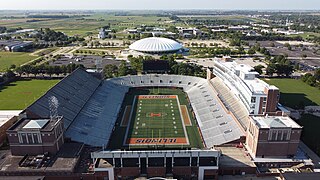
Memorial Stadium is a stadium on the campus of the University of Illinois Urbana-Champaign in Champaign, Illinois, United States. The stadium, used primarily for football, is a memorial to the university's students who died in World War I; their names are engraved on the nearly 200 pillars surrounding the stadium's façade. With a capacity of 60,670, the stadium is primarily used as the home of the university's Fighting Illini football team.

Illinois College is a private liberal arts college in Jacksonville, Illinois. It is affiliated with the United Church of Christ and the Presbyterian Church (USA). It was the second college founded in Illinois but the first to grant a degree. It was founded in 1829 by the Yale Band, students from Yale College who traveled westward to found new colleges. It briefly served as the state's first medical school, from 1843 to 1848.
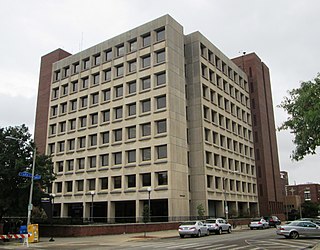
The College of Liberal Arts and Sciences (LAS) is the largest college of the University of Illinois Urbana-Champaign. The college was established in 1913 through the merger of the College of Literature and Arts and the College of Science. The college offers seventy undergraduate majors, as well as master's and Ph.D. programs. As of 2020, there are nearly 12,000 undergraduate students and 2,500 graduate students attending the College of Liberal Arts and Sciences.
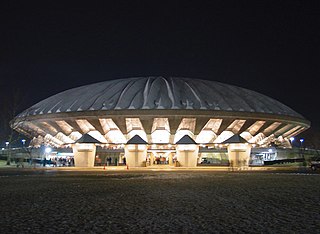
The State Farm Center is a large dome-shaped 15,544-seat indoor arena located in Champaign, Illinois, owned and operated by the University of Illinois Urbana-Champaign. The arena hosts games for the Illinois Fighting Illini men's basketball, women's basketball, and wrestling teams. It also doubles as a performance and event center, and is one of the largest venues between Chicago and St. Louis. It opened in 1963 and was known until 2013 as Assembly Hall until State Farm Insurance acquired naming rights as part of a major renovation project.

The Coronado Performing Arts Center, in Rockford, Illinois, is a 2,400-seat theatre, designed by architect Frederic J. Klein. The theatre cost $1.5 million to build, and opened on October 9, 1927.

The Krannert Center for the Performing Arts is an educational and performing arts complex located at 500 South Goodwin Avenue in Urbana, Illinois and on the campus of the University of Illinois Urbana-Champaign. Herman C. Krannert, an industrialist who founded Inland Container Corporation and an alumnus of the university, and his wife, Ellnora Krannert, made a gift of $16 million that led to the Krannert Center's construction. Max Abramovitz, the architect who designed the facility, was also an Illinois alumnus.

Lincoln Hall is one of the eleven buildings that make up the Main Quad of the University of Illinois Urbana-Champaign (UIUC). The building's exterior depicts scenes of the life of Abraham Lincoln and is located on the southwest corner of the Quad. The building is home of the Liberal Arts and Science College. Lincoln Hall contains four floors which includes classrooms, a theater, conference rooms, and offices for faculty. Specifically, the Department of Communication, Department of Sociology, several LAS administrative offices, including Student Academic Affairs and the Dean's Office reside in Lincoln Hall. Over the years, Lincoln Hall has emerged as the second most used classroom building on campus, with 350 sections of classes held there each semester. Almost every student will have taken a class in Lincoln Hall by graduation.
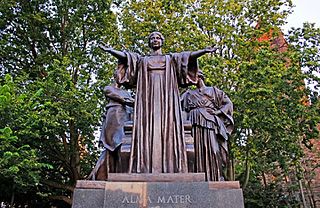
The University of Illinois Urbana-Champaign is an academic research institution that is the flagship campus of the University of Illinois System. Since its founding in 1867, it has resided and expanded between the twin cities of Champaign and Urbana in the State of Illinois. Some portions are in Urbana Township.

Jesse Hall, formerly New Academic Hall, is the main administration building for the University of Missouri. Its dome has towered 180 feet (55 m) above the south end of David R. Francis Quadrangle since its completion in 1895. In the lawn in front of Jesse Hall are The Columns, all that remains of its predecessor Academic Hall, which was destroyed by fire in 1892. The building contains the office of the chancellor, university registrar, graduate school, admissions, and financial aid. One of the most photographic landmarks in Missouri, the building was designed by Missouri architect Morris Frederick Bell, and is his largest surviving work. Jesse Auditorium had hosted graduations and many university functions over the years. The University Concert Series presents national and international concerts, Broadway shows, performers, bands, speakers, and theater to the largest auditorium in Columbia. As the former home of the School of Music, student performances occasionally take place. The building is the most prominent contributing structure to the David R. Francis Quadrangle National Register of Historic Places District. In 1922, "New Academic Hall" was renamed "Jesse Hall" in honor of retiring University President Richard Henry Jesse.

The Alma Mater, a bronze statue by sculptor Lorado Taft, is a beloved symbol of the University of Illinois Urbana-Champaign. The 10,000-pound statue depicts a mother-figure wearing academic robes and flanked by two attendant figures representing "Learning" and "Labor", after the university's motto "Learning and Labor." Sited at the corner of Green and Wright Streets at the heart of the campus, the statue is an iconic figure for the university and a popular backdrop for student graduation photos. It is appreciated for its romantic, heraldic overtones and warmth of pose. The statue was removed from its site at the entrance to the university for restoration in 2012 and was returned to its site in the spring of 2014.

Perelman Quadrangle, also known as Perelman Quad, is an area of the University of Pennsylvania's campus in West Philadelphia that was redeveloped in 2001 in conjunction with a comprehensive renovation of Houston Hall. The renovation, performed by the architectural firm of Robert Venturi and Denise Scott Brown, also built a large open plaza formerly known as Wynn Commons, named for real estate businessman Steve Wynn. The name was changed to Penn Commons in February 2018 amid sexual misconduct allegations.

Clarence Howard Blackall was an American architect who is estimated to have designed 300 theatres.

Engineering Hall is an administrative building at the University of Illinois at Urbana–Champaign. It is located in the south end of the Bardeen Quadrangle on Green Street in Urbana, Illinois, facing the Illini Union. Engineering Hall serves all disciplines within the UIUC College of Engineering and is well known for representing the school's colors with its orange bricks and blue roof. In addition to many offices and conference rooms, Engineering Hall also includes two computer labs and four lecture halls. Engineering Hall also houses many engineering-based student organizations in its offices.

Tina Weedon Smith Memorial Hall, located at 805 S. Mathews Avenue in Urbana, Illinois, is an historic building on the campus of the University of Illinois at Urbana-Champaign. Smith Hall is located just off the main quad of campus and is just east of Foellinger Auditorium. The building was constructed in 1917-21 and was designed in the Beaux-Arts style by James M. White and George E. Wright.

The construction of State Farm Center, originally known as the Assembly Hall, at the University of Illinois at Urbana–Champaign consisted of building a huge indoor arena with a 400-foot-diameter (120 m) concrete dome whose center height is 125 feet (38 m) above the center floor, and which weighs 10 million pounds. The building is considered an engineering marvel because of the unique method used to build the concrete roof. State Farm Center, the first-ever concrete dome arena, hosts the campus's teams in men's and women's basketball, numerous concerts and other events. It holds sentimental value for numerous alumni and fans alike and attracts attention for its design and construction. The construction of the Assembly Hall was conceived to provide UIUC with needed space for ceremonies and athletic events. The university’s population had outgrown the largest building on campus at that time, the Auditorium, and desired one building that could hold the entire university class. The design of the new building, by Max Abramovitz, called for the construction of one of the world’s largest edge-supported structure. The assembly hall was completed in 1963, and was dedicated on Honors Day, Friday May 3.

The Center for the Performing Arts (CPA) building is the largest building of the Miami University College of Creative Arts. It houses the Miami University Theater, theater department, and music department. Originally these programs were distributed between Fisher Hall and Hall Auditorium, and were moved to CPA after its construction in 1969.

The Main Library is a historic library on the campus of the University of Illinois Urbana-Champaign in Urbana, Illinois. Built in 1924, the library was the third built for the school; it replaced Altgeld Hall, which had become too small for the university's collections. Architect Charles A. Platt designed the Georgian Revival building, one of several on the campus which he designed in the style. The building houses several area libraries, as well as the University Archives and the Rare Book & Manuscript Library. The Main Library is the symbolic face of the University Library, which has the second largest university library collection in the United States.
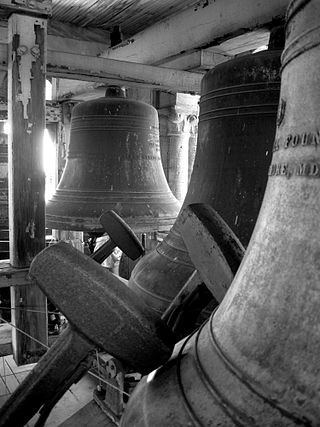
The Senior Memorial Chime, known more commonly as the Altgeld Chimes, is a 15-bell chime in Altgeld Hall Tower on the central campus of the University of Illinois Urbana-Champaign, in Urbana, Illinois, United States.

The English Building, previously known as the Woman's Building and Bevier Hall, is a historic structure on the campus of the University of Illinois Urbana-Champaign. It is located on the west side of the Main Quad between Lincoln Hall and the Henry Administration Building. The original portion of the English Building, designed by McKim, Mead & White, was completed in 1905 and subsequently expanded in 1913 and 1924. The distinctive columned front, which faces the Main Quad, dates to the 1913 addition. Since 1956, the English Building has been home to the university's Department of English.





















